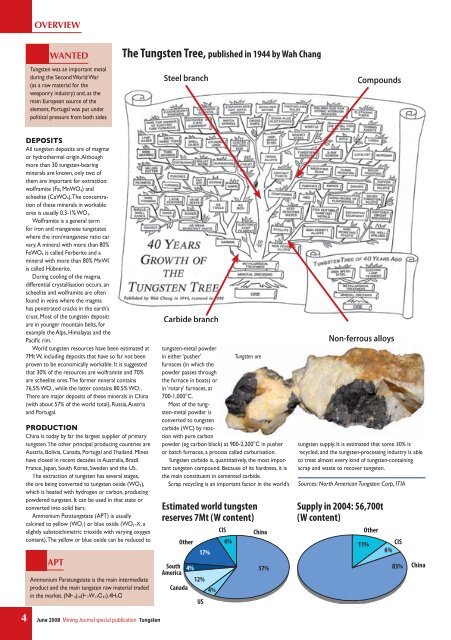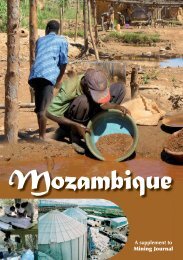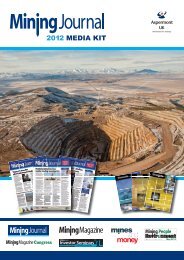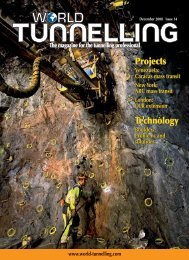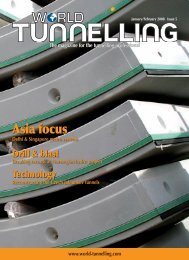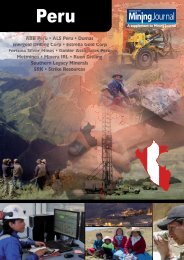Tungsten - Mining Journal
Tungsten - Mining Journal
Tungsten - Mining Journal
Create successful ePaper yourself
Turn your PDF publications into a flip-book with our unique Google optimized e-Paper software.
DEPOSITS<br />
All tungsten deposits are of magmatic<br />
or hydrothermal origin. Although<br />
more than 30 tungsten-bearing<br />
minerals are known, only two of<br />
them are important for extraction:<br />
wolframite (Fe, MnWO4) and<br />
scheelite (CaWO4). The concentration<br />
of these minerals in workable<br />
ores is usually 0.3-1% WO3.<br />
Wolframite is a general term<br />
for iron and manganese tungstates<br />
where the iron/manganese ratio can<br />
vary. A mineral with more than 80%<br />
FeWO4 is called Ferberite and a<br />
mineral with more than 80% MnWO MnWO4<br />
is called Hübnerite.<br />
During cooling of the magma,<br />
differential crystallisation occurs, and<br />
scheelite and wolframite are often<br />
found in veins where the magma<br />
has penetrated cracks in the earth’s<br />
crust. Most of the tungsten deposits<br />
are in younger mountain belts, for<br />
example the Alps, Himalayas and the<br />
Pacifi c rim.<br />
World tungsten resources have been estimated at<br />
7Mt W, including deposits that have so far not been<br />
proven to be economically workable. It is suggested<br />
that 30% of the resources are wolframite and 70%<br />
are scheelite ores. The former mineral contains<br />
76.5% WO3, while the latter contains 80.5% WO3.<br />
There are major deposits of these minerals in China<br />
(with about 57% of the world total), Russia, Austria<br />
and Portugal.<br />
4<br />
OVERVIEW<br />
WANTED<br />
<strong>Tungsten</strong> was an important metal<br />
during the Second World War<br />
(as a raw material for the<br />
weaponry industry) and, as the<br />
main European source of the<br />
element, Portugal was put under<br />
political pressure from both sides.<br />
PRODUCTION<br />
China is today by far the largest supplier of primary<br />
tungsten. The other principal producing countries are<br />
Austria, Bolivia, Canada, Portugal and Thailand. Mines<br />
have closed in recent decades in Australia, Brazil,<br />
France, Japan, South Korea, Sweden and the US.<br />
The extraction of tungsten has several stages,<br />
the ore being converted to tungsten oxide (WO2),<br />
which is heated with hydrogen or carbon, producing<br />
powdered tungsten. It can be used in that state or<br />
converted into solid bars.<br />
Ammonium Paratungstate (APT) is usually<br />
calcined to yellow (WO3) or blue oxide (WO3-X, a<br />
slightly substoichimetric trioxide with varying oxygen<br />
content). The yellow or blue oxide can be reduced to<br />
APT<br />
Ammonium Paratungstate is the main intermediate<br />
product and the main tungsten raw material traded<br />
in the market. (NH4)10(H2W12O42).4H2O<br />
June 2008 <strong>Mining</strong> <strong>Journal</strong> special publication <strong>Tungsten</strong><br />
The <strong>Tungsten</strong> Tree, published in 1944 by Wah Chang<br />
Steel branch<br />
Carbide branch<br />
tungsten-metal powder<br />
in either ‘pusher’<br />
<strong>Tungsten</strong> ore<br />
furnaces (in which the<br />
powder passes through<br />
the furnace in boats) or<br />
in ‘rotary’ furnaces, at<br />
700-1,000°C.<br />
Most of the tungsten-metal<br />
powder is<br />
converted to tungsten<br />
carbide (WC) by reaction<br />
with pure carbon<br />
powder (eg carbon black) at 900-2,200°C in pusher<br />
or batch furnaces, a process called carburisation.<br />
<strong>Tungsten</strong> carbide is, quantitatively, the most important<br />
tungsten compound. Because of its hardness, it is<br />
the main constituent in cemented carbide.<br />
Scrap recycling is an important factor in the world’s<br />
Estimated world tungsten<br />
reserves 7Mt (W content)<br />
South<br />
America<br />
Other<br />
Canada<br />
4%<br />
12%<br />
17%<br />
US<br />
4%<br />
CIS<br />
6%<br />
China<br />
57%<br />
Compounds<br />
Non-ferrous alloys<br />
tungsten supply. It is estimated that some 30% is<br />
recycled, and the tungsten-processing industry is able<br />
to treat almost every kind of tungsten-containing<br />
scrap and waste to recover tungsten.<br />
Sources: North American <strong>Tungsten</strong> Corp, ITIA<br />
Supply in 2004: 56,700t<br />
(W content)<br />
11%<br />
Other<br />
CIS<br />
6%<br />
83%<br />
China


